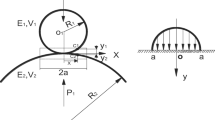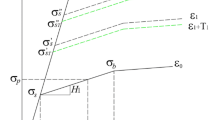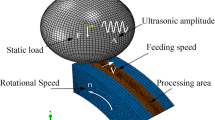Abstract
Two-dimensional ultrasonic rolling (TDUR) is a kind of surface finishing and deformation strengthening technology, which can improve the surface quality and reduce the surface roughness of the workpiece so as to improve its fatigue resistance. In order to study the formation process of the surface topography of 7075 Al-alloy treated by TDUR, a dynamic model of the rolling system was established based on the principle of TDUR to obtain the dynamic force of the roller on the workpiece during the rolling process. The penetration depth model of the workpiece surface under the action of the static load and longitudinal ultrasonic impact was constructed based on the Hertz contact theory and the metal elastic-plastic deformation theory. Then, the simulation model of surface topography was established using the space transformation theory based on the penetration depth model and the trajectory of the roller. Sequentially, the surface topography was reconstructed with the Z-map method. Using the simulation results, the axial profile curve data was extracted, and the surface roughness was calculated by the surface roughness calculation model. Finally, a designed TDUR experiment was carried out to verify the theoretical surface topography and roughness models. And it shows that the simulated surface topography and predicted roughness are in good agreement with the experimental results. The maximum relative error between the predicted roughness and the experimental results is no more than 9%. Under the experimental conditions, the turning marks can be almost eliminated when the static load Fs is 215 N. At this time, the surface profile height was about 1.5 μm, and the roughness Ra is 0.413 μm, which is 78% lower than that of turning. Therefore, the surface topography and surface roughness models proposed in this work can be used to effectively predict the surface topography and surface roughness of 7075 Al-alloy treated by TDUR.











Similar content being viewed by others

Data availability
The datasets used or analyzed during the current study are available from the corresponding author on reasonable request.
References
Lesyk DA, Mordyuk BN, Dzhemelinskyi VV, Prokopenko GI, Dаnylеikо OO (2018) Influence of ultrasonic impact treatment on surface topography and microstructure of AISI 321 stainless steel. Eng Sci 3(10):1–8
Liu D, Liu D, Zhang X, Ma A, Liu C (2020) Microstructural evolution mechanisms in rolled 17-4PH steel processed by ultrasonic surface rolling process. Mater Sci Eng 773:138720
Cheng M, Zhang D, Chen H, Qin W, Li J (2015) Surface nanocrystallization and its effect on fatigue performance of high-strength materials treated by ultrasonic rolling process. Int J Adv Manuf Technol 83(1–4):123–131
Li FQ, Zhao B, Lan SL, Feng ZB (2019) Experiment and simulation of the effect of ultrasonic rolling on the surface properties of Ti-6Al-4V. Int J Adv Manuf Technol 106(5–6):1893–1900
Tolga Bozdana A, Gindy NNZ, Li H (2005) Deep cold rolling with ultrasonic vibrations—a new mechanical surface enhancement technique. Int J Adv Manuf Technol 45(6):713–718
Lu L, Sun J, Li L, Xiong Q (2016) Study on surface characteristics of 7050-T7451 aluminum alloy by ultrasonic surface rolling process. Int J Adv Manuf Technol 87(9–12):2533–2539
Chen X, Zeng QH, He WJ, Liu Q (2020) Pre-deformation enhanced {10–12} twinning in a zirconium alloy. Mater Sci Eng 789:139650
Jiang S, Zheng J (2018) Microstructure and mechanical properties of 7050 aluminum alloy treated by two dimensional ultrasonic rolling. Met Heat Treat 43(05):116–119
Zheng J, Liu H, Ren Y, Zhu L (2020) Effect of two-dimensional ultrasonic rolling on grain size and micro-hardness of 7075 aluminum alloy. Int J Adv Manuf Technol 106(9–12):1–8
Gavrilova TM (2008) Contact friction in the deformation zone during ultrasonic surface plastic deformation. Russ Eng Res 28(8):764–768
Zheng J, Liu H, Ren Y, Zhu L (2020) Effect of two-dimensional ultrasonic rolling on grain size and micro-hardness of 7075 aluminum alloy. Int J Adv Manuf Technol 106(1–2):503–510
Zheng J, Zhu L, Liu H, Ren Y (2020) Overall evaluation of the surface integrity in two-dimensional ultrasonic surface rolling 7050 Al alloy. J Braz Soc Mech Sci Eng 42(6):1055–1074
Liu H, Zheng J, Guo Y, Zhu L (2020) Residual stresses in high-speed two-dimensional ultrasonic rolling 7050 aluminum alloy with thermal-mechanical coupling. Int J Mech Sci 186:105824
Li G, Tang J, Zhou W, Li L (2018) Fatigue life prediction of workpiece with 3D rough surface topography based on surface reconstruction technology. J Cent South Univ 25(9):2069–2075
Cabanettes F, Joubert A, Chardon G, Dumas V, Rech J, Grosjean C, Dimkovski Z (2018) Topography of as built surfaces generated in metal additive manufacturing: a multi scale analysis from form to roughness. Precis Eng 52:249–265
Liu H, Wang H, Huang Z, Wang Q, Chen Q (2020) Comparative study of very high cycle tensile and torsional fatigue in TC17 titanium alloy. Int J Fatigue 139:105720
Dixon B, Barter S, Mazeika R (2018) Quantification of the fatigue severity of porosity in aluminium alloy 7050-T7451 thick plate. Int J Fatigue 114:217–225
Lavernhe S, Quinsat Y, Lartigue C (2010) Model for the prediction of 3D surface topography in 5-axis milling. Int J Adv Manuf Technol 51(9–12):915–924
Chen W, Xie W, Huo D, Yang K (2018) A novel 3D surface generation model for micro milling based on homogeneous matrix transformation and dynamic regenerative effect. Int J Mech Sci 144:146–157
Jin S, Liu S, Zhang X, Chen K (2019) A unified prediction model of 3D surface topography in face milling considering multi-error sources. Int J Adv Manuf Technol 102(1–4):705–717
Li S, Dong Y, Li Y, Li P, Yang Z, Landers RG (2019) Geometrical simulation and analysis of ball-end milling surface topography. Int J Adv Manuf Technol 102(5–8):1885–1900
Zong W, Li Z, Zhang L, Liang Y, Sun T, An C, Zhang J, Zhou L, Wang J (2013) Finite element simulation of diamond tool geometries affecting the 3D surface topography in fly cutting of KDP crystals. Int J Adv Manuf Technol 68(9–12):1927–1936
Tong J, Zhao J, Chen P, Zhao B (2019) Effect of ultrasonic elliptical vibration turning on the microscopic topography of aluminum alloy surface. Int J Adv Manuf Technol 106(3–4):1397–1407
Qu D, Zhang P, Qiao Z, Wu D, Wang B (2015) A simulation model for predicting three-dimensional surface topography in ultra-precision roll die turning. Int J Adv Manuf Technol 86(1–4):681–689
Wang Y, Fu Z, Dong Y, Liu S, Lu S (2018) Research on surface generating model in ultrasonic vibration-assisted grinding. Int J Adv Manuf Technol 96(9–12):3429–3436
Zhao P, Zhou M, Zhang Y, Qiao G (2018) Surface roughness prediction model in ultrasonic vibration assisted grinding of BK7 optical glass. J Cent South Univ 25(2):277–286
Safari M, Joudaki J (2019) Fabrication of a complicated specimen with two point incremental forming process. Int J Adv Manuf Technol 12(4):83–88
Tabatabaei SM, Dehkordi RK, Safari M (2019) Cold bulge forming of aluminum tubes: effects of geometrical and process parameters on formability and thickness variation in bulged tubes. Trans Indian Inst Metals 72(10):2649–2661
Reza T, Saeid A (2019) Analytical modeling of ultrasonic surface burnishing process: evaluation of through depth localized strain. Int J Mech Sci 151:118–132
Liu Y, Zhao X, Wang D (2013) Effective FE model to predict surface layer characteristics of ultrasonic surface rolling with experimental validation. Mater Sci Technol 30(6):627–636
Li F, Xia W, Zhou Z, Zhao J, Tang Z (2012) Analytical prediction and experimental verification of surface roughness during the burnishing process. Int J Mach Tool Manu 62:67–75
Bougharriou A, Saï WB, Saï K (2010) Prediction of surface characteristics obtained by burnishing. Int J Adv Manuf Technol 51(1–4):205–215
Pak A, Mahmoodi M, Safari M (2020) Experimental investigation of the effects of initial surface roughness on ultrasonic assisted ball burnishing of Al6061-T6. Modares Mech Eng 20(1):87–95
Sagbas A (2011) Analysis and optimization of surface roughness in the ball burnishing process using response surface methodology and desirabilty function. Adv Eng Softw 42(11):992–998
Li G, Qu SG, Pan YX, Li XQ (2016) Effects of the different frequencies and loads of ultrasonic surface rolling on surface mechanical properties and fretting wear resistance of HIP Ti–6Al–4V alloy. Appl Surf Sci 389:324–334
Li L, Kim M, Lee S, Bae M, Lee D (2016) Influence of multiple ultrasonic impact treatments on surface roughness and wear performance of SUS301 steel. Surf Coat Technol 307:517–524
Park JW, Choi BK (1997) The validity of Z-map model for mold and die machining. Int Conf Comp Appl Prod Eng 5–7:172–186
Sivakumar B, Pathak LC, Singh R (2017) Role of surface roughness on corrosion and fretting corrosion behaviour of commercially pure titanium in Ringer’s solution for bio-implant application. Appl Surf Sci 401:385–398
Luo A, Zheng J, Wu H (2012) Kinematics analysis on ultrasonic deep rolling with longitudinal-torsional vibration. Adv Mater Res 630:148–152
Meirovitch L (1975) Elements of vibration analysis. McGraw-Hill, New York
Hang Y (1986) Local stress and its application. Machinery Industry Press, Bei Jing (in chinese)
Chen M (2007) Elasticity and plasticity. Science Press, Beijing (in chinese)
Funding
This work was supported jointly by the Key Research and Development and Promotion Program in Henan Province (No. 202102210062) and the Fundamental Research Funds for the Universities of Henan Province (No. NSFRF200309).
Author information
Authors and Affiliations
Contributions
J. X. Zheng proposed the preliminary ideas about this research. L. X. Zhu., Y. L. Guo, and H. W. Liu designed and performed the experiment. L.X. Zhu processed the test data and wrote the first draft. J.X. Zheng and Y.L. Guo conducted a comprehensive review and revision of the first draft.
Corresponding author
Ethics declarations
Ethics approval and consent to participate
The authors state that this paper is an original work, it has not been published in any journals, and this research does not involve any ethical issues of humans or animals. The authors declare that this research involves no Human Participants and/or Animals.
Consent for publication
The authors confirm the paper described has not been published before; that it is not under consideration for publication elsewhere; that its publication has been approved by all co-authors; that its publication has been approved by the responsible authorities at the institution where the work is carried out. The authors agree to publication in the Journal indicated below and also to publication of the article in English by Springer in Springer’s corresponding English-language journal. The copyright to the English-language article is transferred to Springer effective if and when the article is accepted for publication. The author warrants that his/her contribution is original and that he/she has full power to make this grant. The author signs for and accepts responsibility for releasing this material on behalf of any and all co-authors. The copyright transfer covers the exclusive right to reproduce and distribute the article, including reprints, translations, photographic reproductions, microform, electronic form (offline, online), or any other reproductions of similar nature.
Competing interests
The authors declare no competing interests.
Additional information
Publisher’s note
Springer Nature remains neutral with regard to jurisdictional claims in published maps and institutional affiliations.
Rights and permissions
About this article
Cite this article
Zheng, J., Zhu, L., Guo, Y. et al. Modeling, simulation, and prediction of surface topography in two-dimensional ultrasonic rolling 7075 Al-alloy. Int J Adv Manuf Technol 113, 309–320 (2021). https://doi.org/10.1007/s00170-021-06638-x
Received:
Accepted:
Published:
Issue Date:
DOI: https://doi.org/10.1007/s00170-021-06638-x



